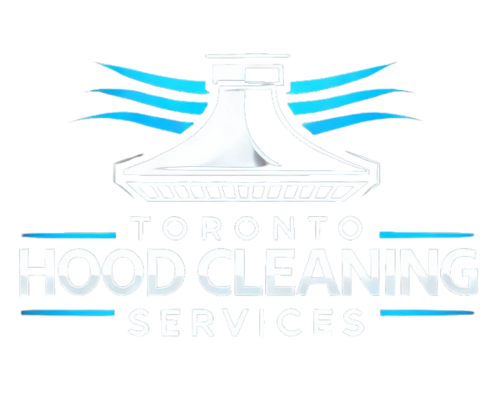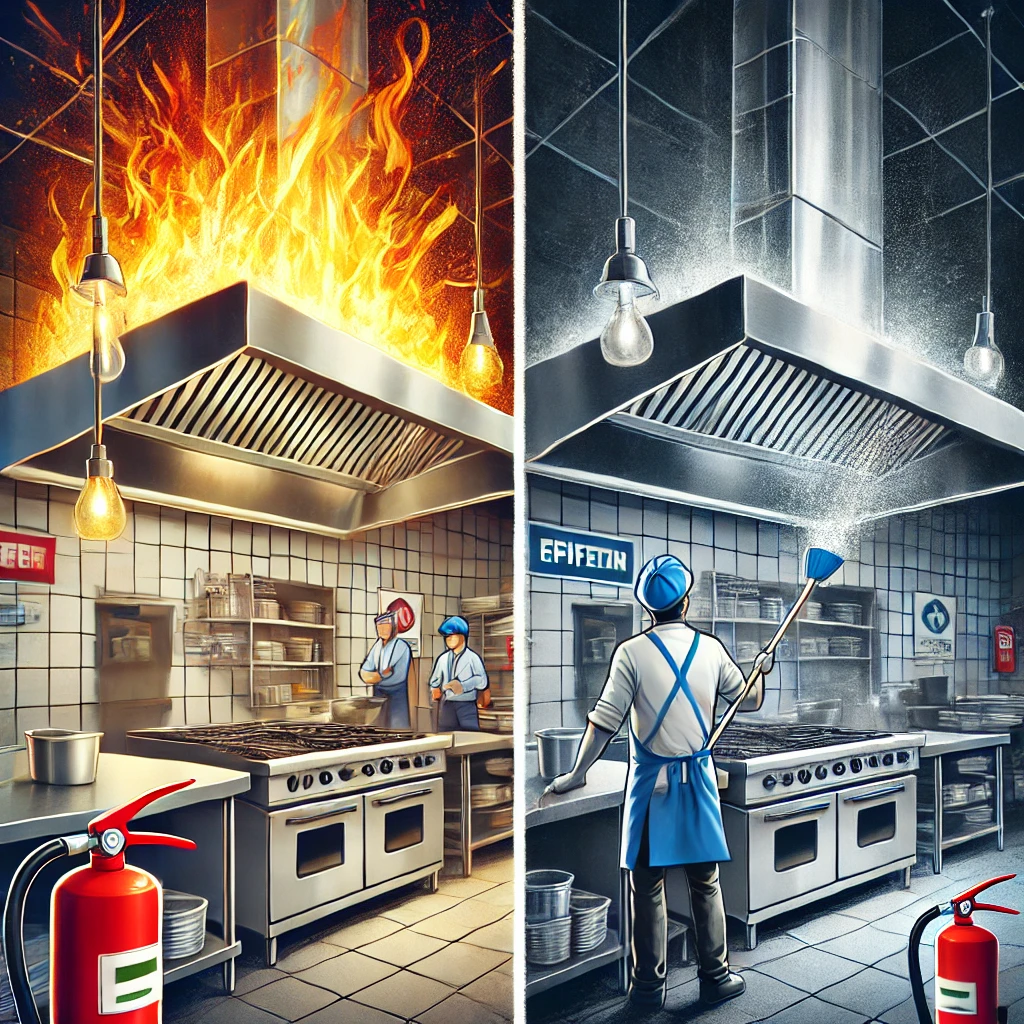The Vital Importance of Hood Cleaning for Fire Safety in Restaurants
Every year, thousands of restaurants across the United States experience devastating fires, resulting in millions of dollars in property damage, injuries, and even loss of life. According to recent reports from the National Fire Protection Association (NFPA), over 85,000 restaurant and commercial kitchen fires occur annually in the U.S., with staggering consequences. As a restaurant owner or manager, ensuring the safety of your staff and patrons should be your top priority. One critical yet often overlooked aspect of fire safety in commercial kitchens is regular hood cleaning. This blog post will explore why hood cleaning is essential for fire prevention, regulatory compliance, and overall kitchen efficiency.
Fire Prevention Through Regular Hood Cleaning
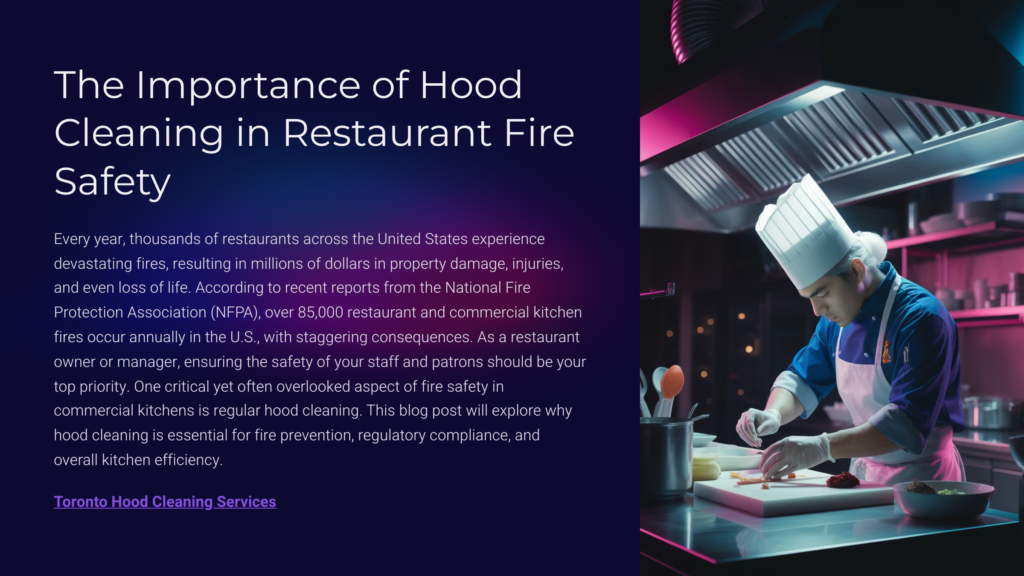
Grease accumulation in exhaust hoods and ducts is the primary culprit behind many restaurant fires. As cooking vapors rise, they carry grease particles that deposit on surfaces throughout the ventilation system. Over time, this buildup becomes a significant fire hazard, ready to ignite at the slightest spark or excessive heat.
Regular hood cleaning mitigates this risk. The National Fire Protection Association (NFPA) strongly recommends consistent cleaning schedules to maintain safe kitchen environments. This is particularly important for restaurants using equipment like grills, fryers, or woks, which are leading causes of kitchen fires due to their high-heat cooking methods.
Regulatory Compliance
Beyond the obvious safety concerns, maintaining clean kitchen ventilation systems is also a matter of regulatory compliance. Health and safety regulations mandate regular cleaning and maintenance of these systems. Failure to comply can result in substantial fines and, in severe cases, even forced closure of your establishment. By prioritizing hood cleaning, you protect your business from fire hazards and ensure you meet legal requirements.
Frequency of Hood Cleaning
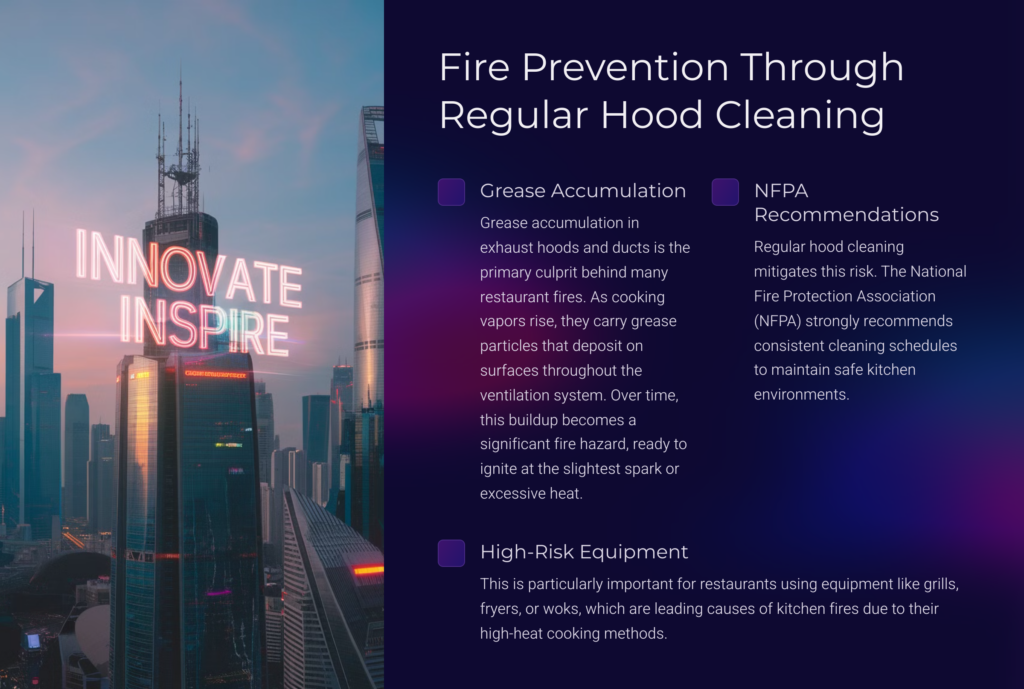
The NFPA provides clear guidelines on how often restaurant hoods should be cleaned, based on the volume of cooking:
- High-volume restaurants: Every 1 to 3 months
- Medium-volume restaurants: Every 6 months
- Low-volume restaurants: Annually
These guidelines serve as a minimum standard. Depending on your specific cooking methods and volume, you may need to clean more frequently to maintain optimal safety levels.
Benefits of Regular Hood Cleaning
While fire prevention is the primary benefit, regular hood cleaning offers additional advantages:
- Enhanced Air Quality: Clean hoods effectively remove smoke, grease, and odors, creating a more pleasant environment for both staff and customers.
- Improved Operational Efficiency: A clean ventilation system performs optimally, reducing energy costs and improving overall kitchen efficiency.
- Extended Equipment Lifespan: Regular cleaning helps prevent corrosion and damage to your ventilation system, potentially saving you money on repairs or replacements in the long run.
Risks of Neglecting Hood Cleaning
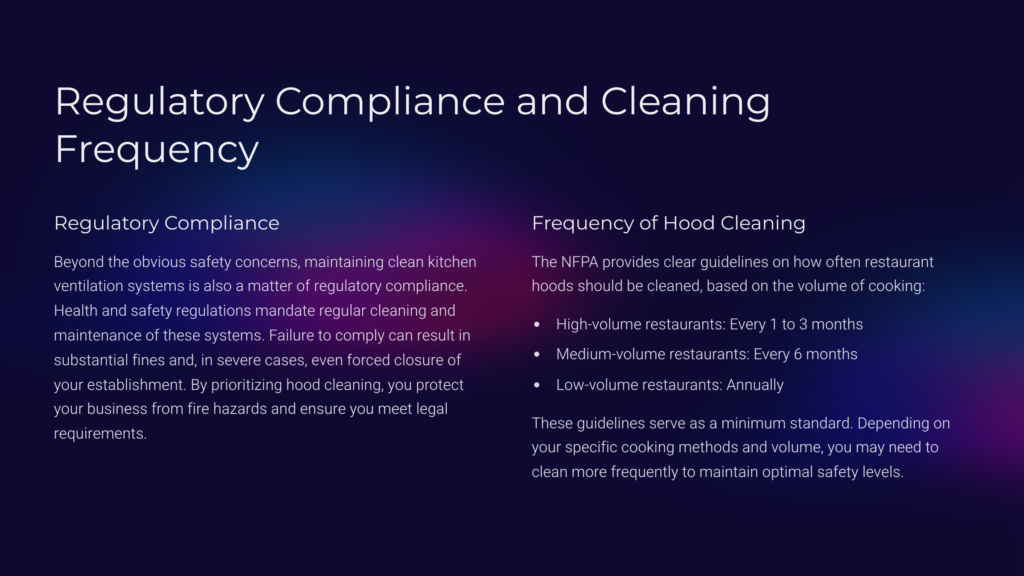
Neglecting hood cleaning can have severe consequences:
- Fire Hazards: Grease buildup can quickly ignite and spread, potentially leading to a catastrophic fire that could destroy your entire restaurant.
- Health Hazards: Accumulated grease can harbor harmful bacteria and mold, posing serious health risks to your staff and customers. This can lead to respiratory problems and other health issues.
- Legal and Financial Risks: Non-compliance with cleaning regulations can result in hefty fines, increased insurance premiums, or even lawsuits in the event of a fire.
Importance of Professional Hood Cleaning Services
While some basic cleaning can be done in-house, engaging professional hood cleaning services regularly is crucial. Look for FDNY-certified companies or those with similar accreditations in your area. These professionals have the expertise, equipment, and techniques necessary to thoroughly clean your system and ensure compliance with safety standards.
Professional cleaners can access hard-to-reach areas, use specialized degreasers, and provide detailed reports on the condition of your ventilation system. This documentation can be invaluable for insurance purposes and regulatory inspections.
Emerging Trends and Technologies
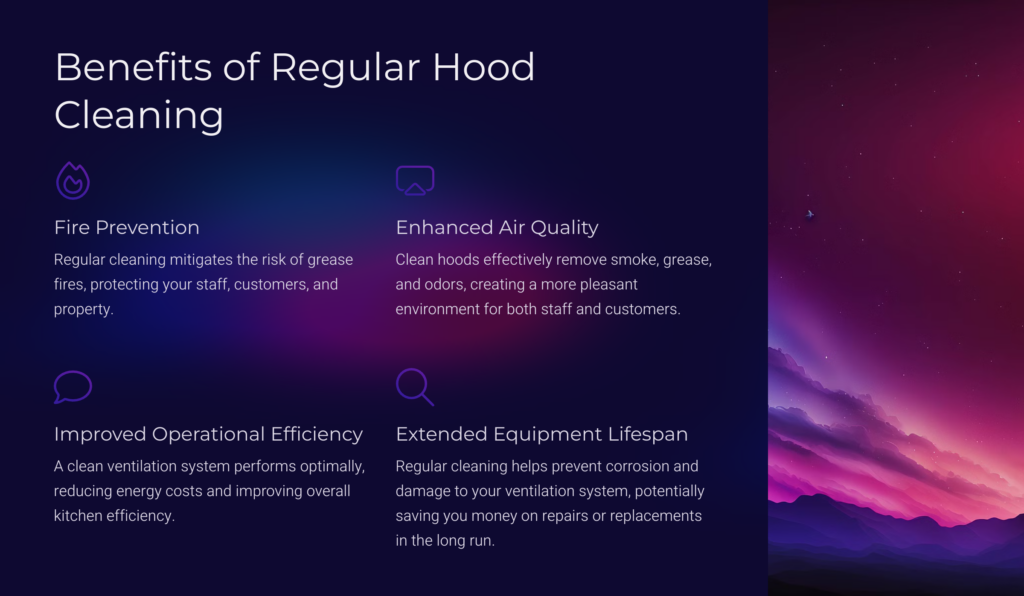
The field of kitchen ventilation is continually evolving, with new technologies emerging to enhance safety and efficiency:
- Smart Hood Systems: Integration of Internet of Things (IoT) technology allows for real-time monitoring of ventilation efficiency and energy consumption. These systems can alert you when cleaning is needed and optimize performance based on cooking volume.
- Advanced Filtration: UV-C filtration systems are becoming increasingly popular. These systems use ultraviolet light to neutralize grease particles and disinfect the air, reducing the frequency of manual cleaning and improving overall air quality.
- Self-Cleaning Hoods: Some manufacturers now offer hoods with built-in cleaning systems that use water and detergent to clean the filters and ductwork automatically. While these systems don’t eliminate the need for professional cleaning entirely, they can extend the intervals between deep cleans.
Additional Fire Safety Measures
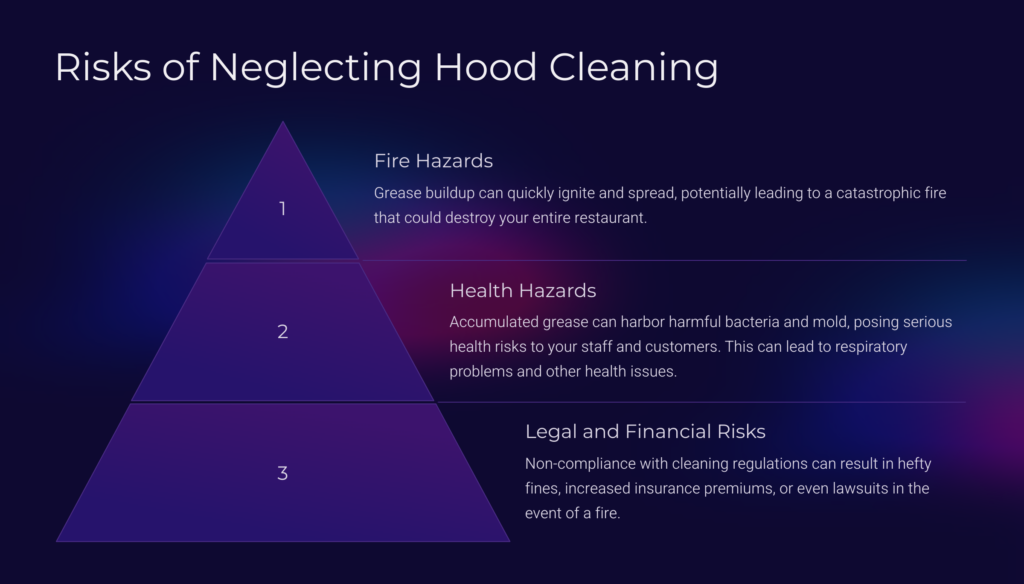
While hood cleaning is crucial, it’s just one part of a comprehensive fire safety strategy for your restaurant. Consider implementing these additional measures:
- Regular Appliance Inspection: Schedule routine inspections and servicing of all kitchen appliances, including range hoods, fryer hoods, and exhaust fans.
- Staff Training: Conduct regular fire safety training sessions for your staff. Cover topics such as fire prevention techniques, proper use of fire extinguishers, and evacuation procedures.
- Fire Suppression Systems: Install and maintain automatic fire suppression systems in your kitchen. These systems can quickly detect and extinguish fires before they spread.
- Clear Evacuation Routes: Ensure all emergency exits are clearly marked and free from obstruction. Conduct regular fire drills to familiarize staff with evacuation procedures.
- Proper Storage: Store flammable materials away from heat sources and ensure proper disposal of oily rags and other potentially combustible items.
Regular hood cleaning is not just a regulatory requirement; it’s a critical component of fire safety in your restaurant. By maintaining a clean and efficient ventilation system, you protect your staff, customers, and business from the devastating consequences of kitchen fires.
As a restaurant owner or manager, take action today:
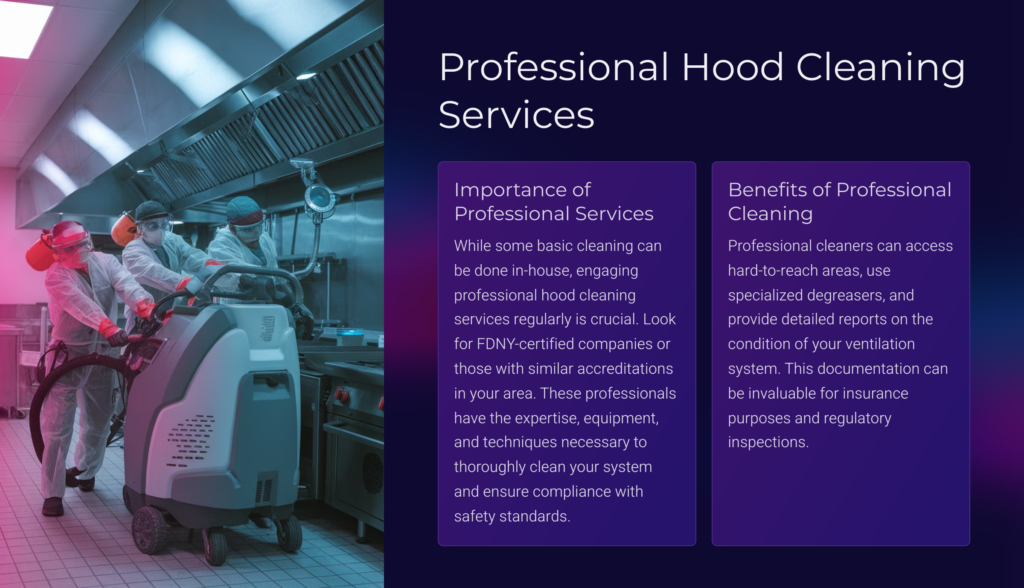
- Review your current hood cleaning schedule and ensure it meets or exceeds NFPA guidelines.
- If you’re not already doing so, engage a professional, certified hood cleaning service for thorough, regular cleanings.
- Consider investing in advanced ventilation technologies to enhance safety and efficiency.
- Implement a comprehensive fire safety training program for your staff.
- Stay informed about the latest regulations and best practices in kitchen fire safety.
Remember, the cost of regular hood cleaning is insignificant compared to the potential losses from a kitchen fire. Prioritize this essential maintenance task to ensure the safety, compliance, and longevity of your restaurant business. Your commitment to fire safety today can prevent a catastrophe tomorrow.
Download this resource [here]
Website version of this resource [here]
